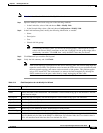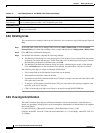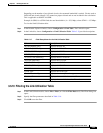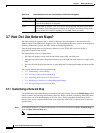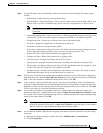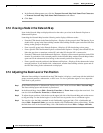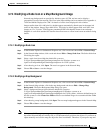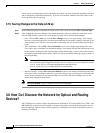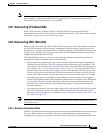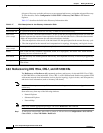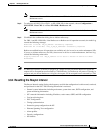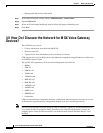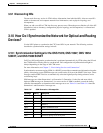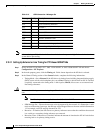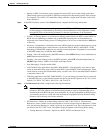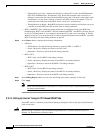
3-51
Cisco Transport Manager Release 6.0 User Guide
78-16845-01
Chapter 3 Building the Network
3.8.1 Discovering CTC-Based NEs
Note The Discovered Network Elements group can be viewed only by users who have all NEs assigned to
them. Therefore, in the Add New NE wizard, the grouping option “Group discovered NEs in the
Discovered Network Elements Group” is not available.
3.8.1 Discovering CTC-Based NEs
When a CTC-based NE is added as a GNE, all NEs that are DCC-connected to the GNE are
automatically discovered. The discovered NEs are added automatically to CTM. The location of the new
NE depends on what you set up in the discovery wizard.
3.8.2 Discovering ONS 155xx NEs
When you add a new ONS 155xx NE to CTM, the discovery process starts. When the process finishes,
all of the NE information (such as inventory, configuration, physical topology, logical circuits, and
discrepancies) is collected and CTM is updated. In addition, neighbors of the added NE are discovered.
To discover new neighbors, the discovery service relies on CDP neighbor information and topology
neighbor information obtained from NEs.
The CTM ONS 155xx discovery service uses the following measures to keep the NE and network
information in CTM synchronized with the NEs themselves:
• Periodic rediscovery based on the resync interval. Periodic rediscovery brings the information in
CTM up to date for all ONS 155xx NEs in the network and rediscovers any new neighbors. The
resync interval can be viewed and reset in the Control Panel. (For information about resetting the
resync interval, see 3.8.4 Resetting the Resync Interval, page 3-53.) If at least one ONS 155xx is
already in the system, the first periodic rediscovery starts when the ONS 155xx NE service starts.
The NE service usually starts when the CTM server is restarted. If no ONS 155xx NEs are in the
system when CTM restarts, the first periodic discovery starts when the first ONS 155xx is added.
• Event-triggered rediscovery launched by certain changes to ONS 155xx NEs. Event-triggered
discovery incrementally updates CTM with the new information. New neighbors of the affected NE
are discovered. The device changes that trigger rediscovery include, but are not limited to, the
following: reboot, CPU switchover, patch and topology changes, and insertion and removal of
physical components.
• User-requested rediscovery. Users can request rediscovery of selected ONS 155xx NEs or the entire
ONS 155xx network at any time. This updates CTM with information about the NEs. For more
information about using rediscovery commands, see 3.8.3 Rediscovering ONS 155xx, CRS-1, and
XR 12000 NEs, page 3-52.
Note Only active NEs (NEs that are in the In Service or Under Maintenance states) can participate in the
rediscovery process.
3.8.2.1 Discovery Information Table
The Discovery Information table displays discovery information for both individual devices for the main
discovery. The main discovery includes the discovery of individual devices plus network-level
computations for topology, discrepancies, and logical circuits. The Discovery Information table shows



